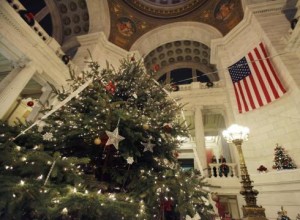 In honor of the season of giving, I have been asked to write the progressive point of view of the second annual showdown between the Holiday Tree and the Christmas Tree. Before delving into the extremely high-stakes debate over what label is given to the conifer in question, let me first say how preposterous I think the tradition is in the first place. Well … both traditions are a bit ludicrous. The older tradition of the tree itself may only be overshadowed in senselessness by the new annual tradition of fighting over what to call it.
In honor of the season of giving, I have been asked to write the progressive point of view of the second annual showdown between the Holiday Tree and the Christmas Tree. Before delving into the extremely high-stakes debate over what label is given to the conifer in question, let me first say how preposterous I think the tradition is in the first place. Well … both traditions are a bit ludicrous. The older tradition of the tree itself may only be overshadowed in senselessness by the new annual tradition of fighting over what to call it.
Don’t get me wrong. Many holiday traditions are, in my mind, foolish. For example, celebrating the resurrection of Jesus by hiding hardboiled eggs we pretend were hidden by a magic bunny. What the …? And make no mistake, I usually enjoy them insofar as they connect family and friends and spread selflessness and joy. I have no problem with harmless absurdity. I love to watch my daughter’s eyes light up, imagining flying reindeer and watching sparkling lights. I feel the warmth in my chest when I hear carols and see colored lights breaking through the deep midwinter gloom.
Now, however, we have resorted to televised talking heads and political pundits barking at one another over separation of church and state and the liberal “attack on Christmas.” The whole thing has spiraled out of control. And, in between the political posturing over the meaning of religious freedom, are endless advertisements for Blue Ray box sets and Lexus luxury automobiles.
So, this is Christmas.
Or is it?
Let’s take a purely historic look at Christmas tradition. December 25 was not selected because it was the actual birthday of Christ. There is little evidence to suggest that date was even near it. December 25 was chosen because it coincided with the idolatrous pagan festival Saturnalia. The exact date of Christ’s birth is unknown. Regardless of the chronological inconsistencies, why is the celebration of the birth of the Christ Child associated with felling a conifer and decorating it like a Vegas showgirl? The answer predates the birth of Christ by centuries.
“An old Babylonish fable told of an evergreen tree which sprang out of a dead tree stump. The old stump symbolized the dead Nimrod, the new evergreen tree symbolized that Nimrod had come to life again in Tammuz! Among the Druids the oak was sacred, among the Egyptians it was the palm, and in Rome it was the fir, which was decorated with red berries during the Saturnalia!” (Walsh, Curiosities of Popular Customs, p. 242).
So, Holiday tree is a more accurate title because it doesn’t limit it to the day observed as the celebration of the hero of the New Testament.
Now let us take a look at our state. Etched into the marble above the city side doors of the Rhode Island State House are the words, “To hold forth a lively experiment that a most flourishing civil state may stand and best be maintained with full liberty in religious concernments.” This could be interpreted one of two ways. “Everyone is free to believe what they want, but keep it out of government.” Or “If one faith is represented in this house, they all must be represented in this house.” Whether the majority (or loud minority as the case may be) chooses to believe it or not, there are other faiths in Rhode Island that do not embrace the Christian doctrine. Rhode Island, founded as a sanctuary from religious persecution by Roger Williams, should embrace the idea of either of the interpretations of the “lively experiment.” I tend to embrace the latter interpretation of the inscription.
By all means. call it a Christmas tree. Today, that’s what it is. If you Google Image “Christmas,” you will inevitably come up with thousands of images involving decorated evergreens. However, understand that that same liberty must be granted to other religious beliefs statewide. If that means placing a Menorah on the state-side steps of the State House and allowing prayer facing Mecca five times a day and a Kwanzaa celebration in the rotunda and a Lammas fruit blessing at all four corners of the House and Senate Chambers, so be it.
It is when taxpayer money or public facilities are used to demonstrate preference of one faith-based activity over another that elicits legal and ethical concern.
I plan on putting up my Christmas tree this year. I have friends who will celebrate eight nights of the festival of lights. Faith-based celebrations are a personal preference and tradition. What others do, provided it causes no harm to others, does not affect me in the least. And they deserve to be called by their appropriate nomenclature. But let’s stop the sensationalism of non-issues and leave religious traditions out of political posturing for the sake of all faiths or lack thereof.
We have enough newsworthy activity, from a hyper-local to a global level, to occupy the political spectrum without going to battle over whether to call it a Christmas tree or a Holiday tree. Let’s keep real news in the media and keep holidays in the heart.